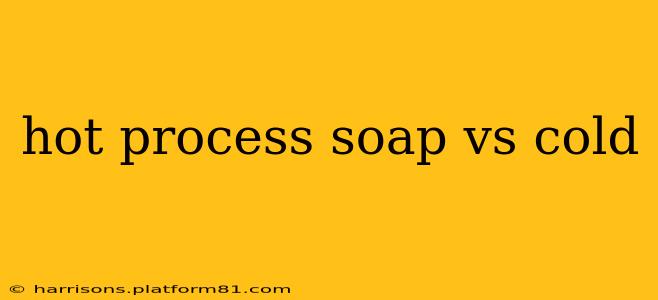Choosing between hot process and cold process soap making can feel overwhelming for beginners. Both methods produce soap, but they differ significantly in their process, resulting in soaps with unique characteristics. This guide delves into the key differences to help you decide which method is right for you.
What is Cold Process Soap?
Cold process soap making is the traditional method, characterized by a lower initial temperature and a longer curing time. This process involves mixing oils and lye, allowing the saponification (the chemical reaction that transforms oils and lye into soap) to occur at room temperature. The resulting soap requires several weeks to cure, allowing excess water to evaporate and the soap to harden.
Advantages of Cold Process Soap:
- Superior Lather: Cold process soaps generally produce a richer, creamier lather due to the slower saponification process.
- Customization: Offers more creative freedom with add-ins like herbs, clays, and essential oils.
- Gentler on Skin: Many find cold process soaps gentler on sensitive skin due to the retained glycerin.
- Longer Shelf Life (After Curing): Once fully cured, cold process soaps have a significantly longer shelf life.
Disadvantages of Cold Process Soap:
- Longer Curing Time: Requires 4-6 weeks of curing before use, significantly delaying the soapmaking process.
- More Time-Consuming: The entire process is more labor-intensive and time-consuming.
- Requires More Patience: Soapmakers need patience to wait for the curing process to complete.
What is Hot Process Soap?
Hot process soap making accelerates the saponification process using heat. This is achieved by cooking the soap batter in a slow cooker, double boiler, or other heat source. This significantly shortens the curing time, though it still requires a few days for post-processing.
Advantages of Hot Process Soap:
- Faster Curing Time: Reduces curing time from weeks to days.
- Less Time-Consuming: Quicker overall process compared to cold process.
- Immediate Use (After a Few Days): The soap can be used sooner after the cooking process.
- More Predictable Results: Consistent results are often easier to achieve.
Disadvantages of Hot Process Soap:
- Less Creamy Lather: The faster saponification may result in a less luxurious lather compared to cold process.
- Limited Add-Ins: Some additives may not be suitable for the higher temperatures involved in hot process.
- Potentially Harsh on Sensitive Skin (Sometimes): Some find hot process soap slightly harsher on skin, though this is not always the case.
Which Method is Better? Hot Process or Cold Process?
There's no universally "better" method; the optimal choice depends on your priorities and preferences. Cold process is ideal for those seeking a luxurious lather, maximum customization, and are willing to invest time for curing. Hot process is perfect for those prioritizing speed, convenience, and immediate results.
How Long Does Hot Process Soap Take to Cure?
While significantly shorter than cold process, hot process soap still needs a few days to cure. This allows for complete saponification and allows excess water to evaporate, resulting in a firmer bar. Typically, a few days to a week is sufficient, but longer curing is always better.
Can You Add Essential Oils to Hot Process Soap?
Yes, you can add essential oils to hot process soap, but be mindful of the heat. Some essential oils are more heat-sensitive than others, so it's important to choose oils that are more heat stable and add them towards the end of the cooking process to minimize degradation.
Is Hot Process Soap Gentler on Skin?
Whether hot process soap is gentler on skin than cold process is debatable. Some find hot process soaps slightly harsher, but this is often subjective and can depend on factors such as the specific oils used and the individual's skin type.
What is the Difference Between Cold Process and Melt and Pour Soap?
This is a crucial distinction! Both cold process and hot process involve making soap from scratch using lye and oils. Melt and pour soap, on the other hand, uses a pre-made soap base that is melted and poured into molds. It is a much simpler, faster process but offers less customization and control.
Ultimately, the best way to determine which soapmaking method suits you is to try both! Each process offers unique benefits and challenges, allowing for a personalized soapmaking experience.
